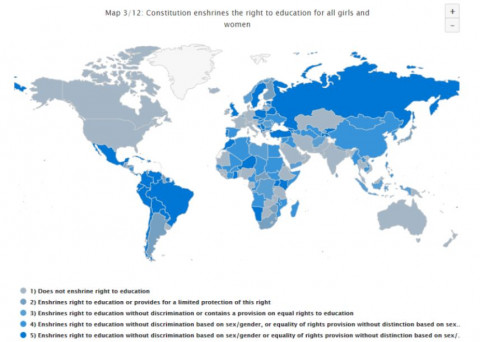
GCED Basic Search Form
Quick Search
You are here
News

UNESCO’s Her Education Rights Atlas (HER Atlas) is designed to measure the degree of protection of girls’ and women’s education rights in national legal frameworks. Her Atlas was launched at the G7 France/UNESCO international conference on girls’ education in July and is part of UNESCO’s ‘Her education, our future’ Initiative. We feature some of its findings today on International Day of the Girl Child. The Atlas provides the latest information on the status of girls’ and women’s right to education in countries’ constitutions, legislation and regulations, serving as a strong monitoring and advocacy tool.
More than 70 years after the adoption of the Universal Declaration of Human Rights, the right to education is still not realized for many girls and women worldwide.
Finding 1: Only 44% of all States enshrine the right to education within their constitution without discrimination based on sex or gender
Despite numerous reaffirmations by the international community of its strong commitment to achieve gender equality in education and the considerable progress in recent decades, poverty, pregnancy, early marriage, gender-based violence and traditional attitudes are among the many obstacles that stand in the way of girls and women fully exercising their right to participate in, complete and benefit from education.
Findings 2- 3 from the 35 States fully analysed for the pilot phase
- 29% set the minimum age of marriage at 18 for girls
- Only 9% protect from all forms of violence in educational institutions, including corporal punishment and psychological, physical and sexual violence
Normative instruments such as international declarations or conventions should not just be ratified but also implemented. This cannot be achieved without solid national legal frameworks that are rights-based, gender responsive and inclusive.
Finding 4: 22% of the 35 States fully analysed by the team enshrine the right to education within their legislation without discrimination based on sex or gender for the first phase
The UNESCO Convention against Discrimination in Education lays down core elements of the right to education. It prohibits any form of discrimination in education based on sex, in law and in fact, and provides for equal opportunities and chances to succeed in education, regardless of gender. The UN Convention on the Elimination of all forms of Discrimination against Women is the only legally-binding text focusing on the specific needs and circumstances of girls’ and women’s education and adopts an explicit gender perspective, ensuring to all an equal right of access to education, equal rights within education and equal rights through education. This commitment has been further reaffirmed by SDG 4, notably target 4.5, which requires States to “eliminate gender disparities in education and ensure equal access to all levels of education and vocational training for the vulnerable” by 2030.
Findings 5-8 from the 35 States fully analysed for the first phase:
- 32% guarantee at least 9 years of compulsory education in the legal framework
- 46% do not guarantee free education, or guarantee only progressively free education in the legal framework
- 17% have aligned the minimum age of employment with the end of compulsory education, and that age does not fall below 15 years
- 20% of legal frameworks contain a provision that restricts the right to education of pregnant or parenting girls
Strong and comprehensive constitutional, legislative and regulatory frameworks are the scaffolding to ensure the right for all to free and compulsory education. They are essential to advance girls’ education and gender equality, and to dismantle barriers to education, including child marriage, child labour and early and unintended pregnancy.
How was Her Atlas developed?
The Interactive Atlas has been developed by a multidisciplinary team in the Education Sector of UNESCO to support advocacy and monitoring of national normative frameworks that regulate girls’ and women’s right to education and to foster sharing of knowledge, experience and practices at country level. The first iteration is using 12 indicators to measure the status of national legal frameworks on girls’ and women’s right to education and includes information and data:
- on all States for the first three indicators, and
- on 35 countries for the other 9, with the ultimate aim to cover all States.
This tool is in progress and is being developed. It will be further expanded and updated periodically to measure changes in the lead up to 2030, the deadline set for SDG 4. UNESCO collected and analyzed constitutions, laws, regulations, circulars and decrees available in national legal frameworks. The 12 indicators identified for the first phase of the project capture factors that have been shown to either strengthen, or act as a barrier to, the right to education of girls and women.
The mapping builds upon the Observatory on the Right to Education, among other sources, and is informed by research carried out on the legal and regulatory provisions using all available sources. Each of the indicators has been assigned a score, from 1 (lowest) to 5 (highest). These scores were based on the analysis of existing legal provisions found in the first phase of the research and the confirmed existence of legal provisions that have achieved score 5. On the basis of these scores, Her Atlas aims to provide the information in a quantitative, visual and readily understood format.
URL:
https://gemreportunesco.wordpress.com/2019/10/11/mapping-girls-right-to-an-education/
